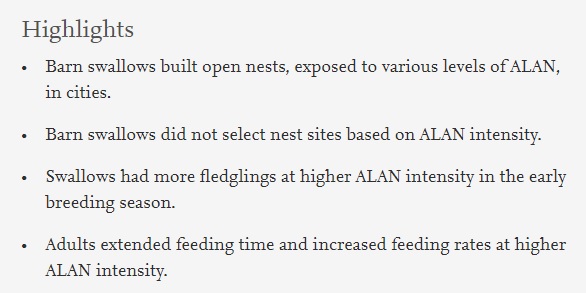Jhih-Syuan Wang, Mao-Ning Tuanmu, Chih-Ming Hung, Effects of artificial light at night on the nest-site selection, reproductive success and behavior of a synanthropic bird, Environmental Pollution, Volume 288, 2021, 117805, ISSN 0269-7491, https://doi.org/10.1016/j.envpol.2021.117805.
(https://www.sciencedirect.com/science/article/pii/S0269749121013877)

Abstract
Understanding how artificial light at night (ALAN) impacts wildlife is increasingly important because more and more species are colonizing urban areas. As most of the bird studies on ALAN use controlled light set inside or around nest-boxes, the ecological effect of ALAN resulting from in situ streetlight on birds remains contentious. The barn swallow (Hirundo rustica) often builds open nests on buildings, which are directly exposed to varying intensity of ALAN, and thus provides a good system to examine the effect of in situ ALAN on birds. By examining the nest-site selection, reproductive success and behavior of barn swallows under various ALAN intensity in Taipei City, we found a positive effect of ALAN on their fledging success; nonetheless, such effect was only found in the swallows’ first brood, but not second one. We also found that parent birds in the nests with higher ALAN intensity had higher feeding rates and more extended feeding time past sunset, which were likely stimulated by the increased begging behavior of their chicks. The night-feeding behavior might contribute to the increased fledging success, especially at the early breeding season. Interestingly, despite of the reproductive benefits obtained from ALAN, we found that the barn swallows did not select nest sites regarding ALAN intensity. The weak nest-site selection perhaps result from the complex life history interactions involving ALAN and/or confounding factors associated with ALAN in cities. This study improves our understanding of how urban birds, especially open-nesting ones, respond to in situ ALAN and provides useful information for developing urban conservation strategies.
Extract, for the full study see https://www.sciencedirect.com/science/article/pii/S0269749121013877
5. Conclusions
Our study suggests that barn swallows may gain reproductive benefits, at least in fledging success, from ALAN and can build nests at sites with various intensity of ALAN. Their high tolerance to ALAN may explain why they can thrive in urban areas. Barn swallows now almost solely nest on human buildings, which provide great protection to this bird from natural disturbances, such as severe weather or predators (Speich et al., 1986). However, the high vigilance and reduced sleeping time under strong light pollution or other human disturbances associated with ALAN in cities can still possibly cause long-term negative impacts on barn swallows. Therefore, artificial light in buildings (e.g., verandahs), where swallows build nests, may have stronger impacts than lampposts along streets; consequently, the former should be carefully deployed to reduce the impact of light pollution on barn swallows nesting in cities. Many other open-nesting birds also breed in or near cities and are directly exposed to high intensity of ALAN. However, most of them may not as highly adapt to human disturbances as barn swallows do and thus are likely to suffer more negative impacts from ALAN than what we found in barn swallows. As urbanization becomes an inevitable trend globally, understanding how ALAN influences the behavior and populations of open-nesting birds and also other urban wildlife species is of increasing importance in conservation (Lao et al., 2020; Rodríguez et al., 2021).
https://www.sciencedirect.com/science/article/pii/S0269749121013877
